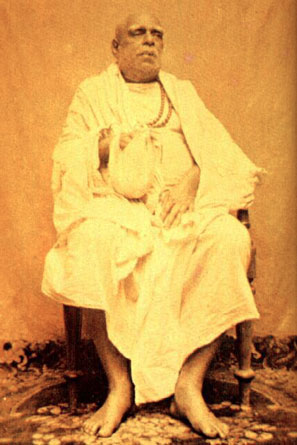śrī śrī guru gaurāṅga jayataḥ!

Year-2, Special On-line Edition
Posted: 2 September, 2009
Dedicated to
nitya-līlā praviṣṭa oṁ viṣṇupāda
Śrī Śrīmad Bhakti Prajñāna Keśava Gosvāmī Mahārāja
Inspired by and under the guidance of
Śrī Śrīmad Bhaktivedānta Nārāyaṇa Gosvāmī Mahārāja
Eulogy to Śrī Gaṅgā-devī
By Śrīla Saccidānanda Bhaktivinoda Ṭhākura

By bringing Gaṅgā to the earth, Bhagīratha Ṛṣī liberated his forefathers. Since that time, the many scriptures have extensively broadcasted Gaṅgā-devī’s glories. Those who do not honour Gaṅgā, mock the scriptures words.
Recently [some time in the late 1800s] one very famous and erudite American chemist exalted our Bhāgīrathī Gaṅgā. He had been in India just a few days before and, after analyzing the Ganges water for micro-bacteria, he reported that Ganges water is completely pure. There was neither any trace of contamination nor any microbial bacteria polluting it.
In contrast, all rivers and streams throughout the world are presently contaminated by a profuse amount of such pollutants. But India’s Gaṅgā is completely devoid of these faults and is pure in every respect. After microscopic analysis of a vessel of Ganges water, the chemist came to know that the glories of the Gaṅgā, as stated in Hindu scriptures, are all very real.
When he returned to his country, he published the results of this great discovery in numerous major newspapers. Also, he stated that it is not only Gaṅgā that is so pure, but all the rivers that are connected to Gaṅgā, as well. He established this through specific methods of analysis.
If the glories of the Gaṅgā had not been proclaimed in scripture, as they have been, but instead had been written according to the opinions of scientists, then the common, innocent man would not have come to revere Gaṅgā to the same extent as we see now. The respected authors of our scriptures, who were nobly dedicated to dharma, have brought the immaculate moods of pure religion to the forefront in all matters. There has been so much benefit as a consequence.
Had these authors instead prescribed life’s injunctions and laws on the grounds of the dry, lifeless soil of mundane science, then the religious moods of India, it seems, could never have spread throughout the world to the extent they have.
* * *
It would be insufficient to consider Gaṅgā-devī’s glories from the material perspective alone. The material world is comprised of twenty-four elemental principles, or tattvas. The jīva himself constitutes the twenty-fifth tattva. The jīvas gross, physical body is made up of the twenty-four material tattvas while the ātmā of the jīva, the twenty-fifth tattva, transcends these. And since the jiva is beyond material energy (prakṛti), he is known as transcendental or incorporeal (aprākṛta). The Supreme Absolute Spirit (Parabrahma) is also an entirely transcendental tattva. Another name of Parabrahma is Viṣṇu: tad viṣṇoḥ paramaṁ padam – that Viṣṇu resides in His supreme, transcendental abode (Ṛg Veda 1.22.20). This point appears repeatedly throughout the Vedas. Śrī Gaṅgā-devī has sprung from the lotus feet of Viṣṇu, who resides in His own supreme abode. Hence, all of the scriptures approve when the corporeal glories of Gaṅgā, as observed within the existence of her water, are discovered.
The American scholar, along with the authors of so many magazines and newspapers, has merely been enchanted by Gaṅgā’s corporeal glories, but there is unlimited glory present in Gaṅgā-devī, beyond her worldly glories. The assembly of śuddha bhaktas (pure devotees) has revealed that if someone resides near the Gaṅgā and drinks her water, hari-bhakti will manifest in his heart. This is so because the water that emanates from the transcendental lotus feet of the supremely merciful Śrī Viṣṇu has the power to awaken bhakti to the lotus feet of Śrī Hari (Viṣṇu). Vyāsa and the other great saints have sung this truth everywhere.
* * *
The living entities who have been overshadowed by contamination are painfully wallowing in total forgetfulness of Śrī Hari. But when they immerse themselves in the waters of the Gaṅgā and sing about the qualities of Śrī Hari, bhakti awakens in their hearts. Only fortunate souls can realize these principal qualities of Gaṅgā, while the realizations of unfortunate souls remain confined solely to Gaṅgās material qualities.
In answer to the doubt that many people repeatedly take bath in the Gaṅgā and drink her waters constantly but still never do hari-bhajana, it can be said that qualities from one object can only be transmitted to one that does not obstruct their transmission.
Electricity can only be transmitted into an object that is a good conductor of electricity, not into an object that is a bad conductor. Similarly, among the jīvas, those that commit certain severe offences become bad conductors of bhakti, which is here likened to electricity. Just as those who perform sinful activities on the strength of chanting the holy name are severe offenders to the holy name (nāma-aparādhīs), those who perform sinful activities with the expectation that Gaṅgā-devī’s glorious waters will purify them of their sins, are terrible offenders.
All types of sins are washed away by bathing in Gaṅgā, yet the aparādha just mentioned is not nullified in the same way. Those who commit this aparādha become bad conductors and are unable to realize the unlimited glories of the Gaṅgā. Consequently, most people these days cannot realize Gaṅgā’s transcendental potency; they simply perceive, by their mundane intelligence, the material composition of her water.
Translated from Śrīla Bhaktivinoda Ṭhākurera Prabandhāvalī
by the Rays of The Harmonist team
![]()